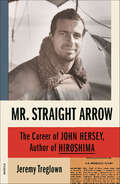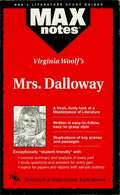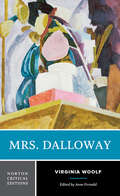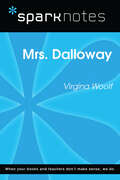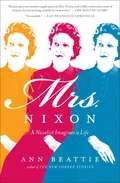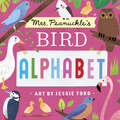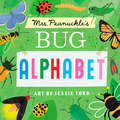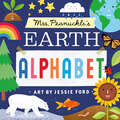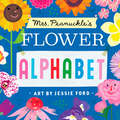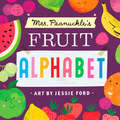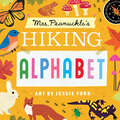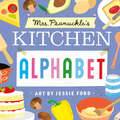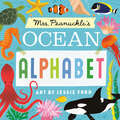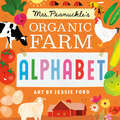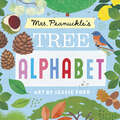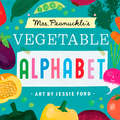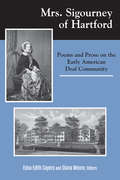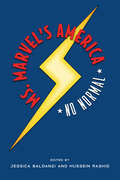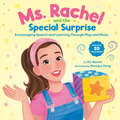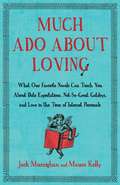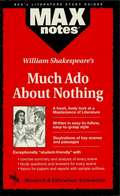- Table View
- List View
Mr. Max
by Lisa Robinson Cindy Peattie Kimberly BarnesTitle contained within StartUp Phonic Core Program. Not Sold Separately
Mr. Straight Arrow: The Career of John Hersey, Author of Hiroshima
by Jeremy TreglownA monumental reevaluation of the career of John Hersey, the author of HiroshimaFew are the books with as immediate an impact and as enduring a legacy as John Hersey’s Hiroshima. First published as an entire issue of The New Yorker in 1946, it was serialized in newspapers the world over and has never gone out of print. By conveying plainly the experiences of six survivors of the 1945 atomic bombing and its aftermath, Hersey brought to light the magnitude of nuclear war. And in his adoption of novelistic techniques, he prefigured the conventions of New Journalism. But how did Hersey—who was not Japanese, not an eyewitness, not a scientist—come to be the first person to communicate the experience to a global audience?In Mr. Straight Arrow, Jeremy Treglown answers that question and shows that Hiroshima was not an aberration but was emblematic of the author’s lifework. By the time of Hiroshima’s publication, Hersey was already a famed war writer and had won a Pulitzer Prize for Fiction. He continued to publish journalism of immediate and pressing moral concern; his reporting from the Freedom Summer and his exposés of the Detroit riots resonate all too loudly today. But his obsessive doubts over the value of his work never ceased. Mr. Straight Arrow is an intimate, exacting study of the achievements and contradictions of Hersey’s career, which reveals the powers of a writer tirelessly committed to truth and social change.
Mrs. Dalloway (MAXNotes Literature Guides)
by David GracerMAXnotes offer a fresh look at masterpieces of literature, presented in a lively and interesting fashion. Written by literary experts who currently teach the subject, MAXnotes will enhance your understanding and enjoyment of the work. MAXnotes are designed to stimulate independent thought about the literary work by raising various issues and thought-provoking ideas and questions. MAXnotes cover the essentials of what one should know about each work, including an overall summary, character lists, an explanation and discussion of the plot, the work's historical context, illustrations to convey the mood of the work, and a biography of the author. Each chapter is individually summarized and analyzed, and has study questions and answers.
Mrs. Dalloway (Norton Critical Editions #0)
by Virginia Woolf“Illuminating and original combination of biographical, historical, literary, and critical sources for Mrs. Dalloway by the leading Woolf scholar who edited the annotated edition of the novel. Diary and letter selections provide fresh contexts. Superb resource for teachers and students!” —Susan Stanford Friedman, University of Wisconsin, Madison This Norton Critical Edition includes: The 1925 first American edition text, introduced and annotated by Anne Fernald. A map of Mrs. Dalloway’s London. An unusually rich selection of contextual materials, including diary entries and letters related to the composition of the novel, essays, short stories, and biographical excerpts, and the only introduction that Virginia Woolf wrote to any of her novels. The voices of other writers are also included, allowing readers to consider the literary passages that influenced Woolf’s art and historical moment. Eight reviews of Mrs. Dalloway, from publication to the present day. A chronology and a selected bibliography. About the Series Read by more than 12 million students over fifty-five years, Norton Critical Editions set the standard for apparatus that is right for undergraduate readers. The three-part format—annotated text, contexts, and criticism—helps students to better understand, analyze, and appreciate the literature, while opening a wide range of teaching possibilities for instructors. Whether in print or in digital format, Norton Critical Editions provide all the resources students need.
Mrs. Dalloway (SparkNotes Literature Guide Series)
by SparkNotesMrs. Dalloway (SparkNotes Literature Guide) by Virginia Woolf Making the reading experience fun! Created by Harvard students for students everywhere, SparkNotes is a new breed of study guide: smarter, better, faster. Geared to what today's students need to know, SparkNotes provides: *Chapter-by-chapter analysis *Explanations of key themes, motifs, and symbols *A review quiz and essay topicsLively and accessible, these guides are perfect for late-night studying and writing papers
Mrs. Nixon
by Ann BeattieDazzlingly original, Ann Beattie's Mrs. Nixon is a riveting exploration of an elusive American icon and of the fiction writer's art. Pat Nixon remains one of our most mysterious and intriguing public figures, the only modern First Lady who never wrote a memoir. Beattie, like many of her generation, dismissed Richard Nixon's wife: "interchangeable with a Martian," she said. Decades later, she wonders what it must have been like to be married to such a spectacularly ambitious and catastrophically self-destructive man. Drawing on a wealth of sources from Life magazine to accounts by Nixon's daughter and his doctor to The Haldeman Diaries and Jonathan Schell's The Time of Illusion, Beattie reconstructs dozens of scenes in an attempt to see the world from Mrs. Nixon's point of view. Like Stephen King's On Writing, this fascinating and intimate account offers readers a rare glimpse into the imagination of a writer. Beattie, whose fiction Vanity Fair calls "irony-laced reports from the front line of the baby boomers' war with themselves," packs insight and humor into her examination of the First Couple with whom boomers came of age. Mrs. Nixon is a startlingly compelling and revelatory work.
Mrs. Peanuckle's Bird Alphabet (Mrs. Peanuckle's Alphabet #5)
by Mrs. PeanuckleFrom the albatross to the zebra finch, Mrs. Peanuckle pulls out her binoculars and introduces toddlers to 26 species of birds from all around the world. Described by a single interesting fact or defining characteristic, each bird proves to be as unique and surprising as the one before. Ever wonder why flamingoes are pink? It’s all those shrimp they eat. Are there birds that can fly backward? Yes, but hummingbirds are the only ones! With colorful, dynamic art, and attention-grabbing text, Mrs. Peanuckle’s birds fly off the page, and in some cases, into the parks and backyards of the children and adults reading this book.Mrs. Peanuckle’s Bird Alphabet is the fifth title in a series of board books celebrating the joy of nature at home and in the backyard, from fresh fruits and vegetables to birds, bugs, and trees.
Mrs. Peanuckle's Bug Alphabet (Mrs. Peanuckle's Alphabet #3)
by Mrs. PeanuckleMrs. Peanuckle’s Bug Alphabet introduces babies and toddlers to all sorts of interesting bugs. Perfect to read aloud, this creepy, crawly adventure will engage children and parents alike with its vibrant illustrations and fascinating facts about bugs. Learning the ABCs has never been so bitingly fun! Mrs. Peanuckle’s Bug Alphabet is the fourth title in a series of board books celebrating the joy of nature at home and in the backyard, from fresh fruits and vegetables to birds, flowers, and trees.
Mrs. Peanuckle's Earth Alphabet (Mrs. Peanuckle's Alphabet #9)
by Mrs. PeanuckleExplore our wondrous planet while learning the ABCs with Mrs. Peanuckle! With playful text, bright illustrations, and sturdy pages, this alphabet book will engage toddlers, and take them on an alphabet adventure through the natural world!Mrs. Peanuckle shares everything that makes Earth so special—and all the important ways we can protect our home from climate change in her latest tour of the ABCs! From A to Z, Mrs. Peanuckle introduces toddlers to 26 different natural-world experiences. With bold, colorful pages, strong graphic art, and exciting design, these simple nature words are sure to be a hit with budding environmentalists and curious young scientists.Collect all of Mrs. Peanuckle's Alphabet books, including: KitchenHikingBirdTreeBugFlowerFruitVegetable
Mrs. Peanuckle's Flower Alphabet (Mrs. Peanuckle's Alphabet #4)
by Mrs. PeanuckleFrom the aster to the zinnia, Mrs. Peanuckle introduces very young children to 26 types of flowers from across the globe. For each one, she offers a single defining characteristic, some of them very surprising. Did you know that there are twice as many orchid species as bird species? It's true! Do flowers taste good? Birds, bees, and butterflies sure think so! You'll even find flowers in certain teas. With bold, colorful pages, strong graphic art, and exciting design, these flowers are certain to be remembered by the children and adults who share this book. Mrs. Peanuckle’s Flower Alphabet is the third title in a series of board books celebrating the joy of nature at home and in the backyard, from fresh fruits and vegetables to birds, bugs, and trees.
Mrs. Peanuckle's Fruit Alphabet: Mrs. Peanuckle's Alphabet Series (Mrs. Peanuckle's Alphabet #2)
by Mrs Peanuckle Jessie FordMrs. Peanuckle’s Fruit Alphabet introduces babies and toddlers to the colorful foods that will help them grow up to be healthy and strong. Children and parents alike will want to devour the fun facts and charming illustrations of fruits from the familiar banana to the not as familiar yumberry. Mrs. Peanuckle’s Fruit Alphabet is the second in a series of board books celebrating the joy nature brings to young children at home and in the backyard, from fresh fruits and vegetables to birds, bugs, flowers, and trees.
Mrs. Peanuckle's Hiking Alphabet
by Mrs. PeanuckleWith playful text, bright illustrations, and sturdy pages, Mrs. Peanuckle's alphabet books will engage toddlers, and take them on an alphabet adventure through the natural world!Explore the wondrous world of hiking while learning the ABCs with Mrs. Peanuckle! Mrs. Peanuckle takes on the outdoors and shares all her favorite animals, plants, and more in her latest tour of the ABCs! From A to Z, Mrs. Peanuckle introduces toddlers to 26 different natural-world experiences. With bold, colorful pages, strong graphic art, and exciting design, these simple nature words are sure to be a hit with budding hikers and curious young scientists. Collect all of Mrs. Peanuckle's Alphabets, including: Kitchen, Hiking, Bird, Tree, Bug, Flower, Fruit, and Vegetable!
Mrs. Peanuckle's Kitchen Alphabet
by Mrs. PeanuckleWith playful text, bright illustrations, and sturdy pages, Mrs. Peanuckle's alphabet books will engage toddlers, and take them on an alphabet adventure through the natural world!Discover the wondrous world of cooking while learning the ABCs with Mrs. Peanuckle! Mrs. Peanuckle introduces toddlers to 26 different tools, foods, and activities that make cooking time the best time! Featuring unique and unexpected words, this is the perfect board book to get kids excited about cooking and nutrition! With bold, colorful pages, strong graphic art, and exciting design, this scrumptious book is sure to be a hit with budding chefs in every kitchen!Collect all of Mrs. Peanuckle's Alphabets, including: Kitchen, Hiking, Bird, Tree, Bug, Flower, Fruit, and Vegetable!
Mrs. Peanuckle's Ocean Alphabet (Mrs. Peanuckle's Alphabet #10)
by Mrs. PeanuckleMrs. Peanuckle's alphabet books engage toddlers with interesting and informative words, graphic art, and sturdy pages!From A to Z, Mrs. Peanuckle introduces toddlers to words about the earth's oceans. These simple nature words are sure to be a hit with budding biologists, curious young environmentalists, and parents and teachers who want to encourage learning and an awareness of our unique planet! Collect all of Mrs. Peanuckle's Alphabet books, including Fruit, Vegetable, Bug, Flower, Bird, Tree, Hiking, Kitchen, and Earth!
Mrs. Peanuckle's Organic Farm Alphabet (Mrs. Peanuckle's Alphabet #11)
by Mrs. PeanuckleLearn the ABC's of organic farming! Mrs. Peanuckle's alphabet books engage toddlers with interesting and informative words, graphic art, and sturdy pages.From A to Z, Mrs. Peanuckle introduces toddlers to words about organic farm life! These simple nature and farm words are sure to be a hit with curious young environmentalists, and parents and teachers who want to encourage learning about the benefits of organic farming! Collect all of Mrs. Peanuckle's Alphabet books, including Fruit, Vegetable, Bug, Flower, Bird, Tree, Hiking, Kitchen, Ocean, and Earth!
Mrs. Peanuckle's Tree Alphabet (Mrs. Peanuckle's Alphabet #6)
by Mrs. PeanuckleWhether they’re short or tall, pruny or smooth, full of berries or flowers or nuts, the 26 types of trees in this alphabet primer are sure to surprise and delight the youngest of readers (and their parents). After all, trees do more for us than sway in the wind. Did you know incense Cedars are perfect for making pencils? (So we can practice writing our ABCs.) Or that Katsura trees are great for climbing? (So we can discover more about trees!) With playful text, bright illustrations, and pages as strong as an oak, Mrs. Peanuckle’s trees will engage toddlers and take them on an alphabet adventure through the natural world.Mrs. Peanuckle’s Tree Alphabet is the sixth and final title in a series of board books celebrating the joy of nature at home and in the backyard, from fresh fruits and vegetables to birds, bugs, and trees.
Mrs. Peanuckle's Vegetable Alphabet (Mrs. Peanuckle's Alphabet #1)
by Mrs Peanuckle Jessie FordMrs. Peanuckle’s Vegetable Alphabet introduces babies and toddlers to a colorful variety of vegetables, from asparagus to zucchini. Perfect to read aloud, this vegetable buffet will delight children and parents alike with its yummy vegetable facts and vibrant illustrations. Learning the ABCs has never been so delicious! Mrs. Peanuckle’s Vegetable Alphabet is the first in a series of board books celebrating the joy of nature at home and in the backyard, from fresh fruits and vegetables to birds, bugs, flowers, and trees.
Mrs. Sigourney of Hartford: Poems and Prose on the Early American Deaf Community
by Edna Edith Sayers Diana MooreLydia Huntley was born in 1791 in Norwich, CT, the only child of a poor Revolutionary war veteran. But her father's employer, a wealthy widow, gave young Lydia the run of her library and later sent her for visits to Hartford, CT. After teaching at her own school for several years in Norwich, Lydia returned to Hartford to head a class of 15 girls from the best families. Among her students was Alice Cogswell, a deaf girl soon to be famous as a student of Thomas Hopkins Gallaudet and Laurent Clerc. Lydia's inspiration came from a deep commitment to the education of girls and also for African American, Indian, and deaf children. She left teaching to marry Charles Sigourney, then turned to writing to support her family, publishing 56 books, 2,000 magazine articles, and popular poetry. Lydia Sigourney never abandoned her passion for deaf education, remaining a supporter of Gallaudet's school for the deaf until her death. Yet, her contributions to deaf education and her writing have been forgotten until now. All of Lydia Sigourney's of Lydia Sigourney's work on the nascent Deaf community is presented in this new volume. Her writing intertwines her mastery of the sentimentalism form popular in her day with her sharp insights on the best ways to educate deaf children. In the process, Mrs. Sigourney of Hartford reestablishes her rightful place in history.
Ms. Marvel's America: No Normal
by Jessica Baldanzi and Hussein RashidContributions by José Alaniz, Jessica Baldanzi, Eric Berlatsky, Peter E. Carlson, Sika A. Dagbovie-Mullins, Antero Garcia, Aaron Kashtan, Winona Landis, A. David Lewis, Martin Lund, Shabana Mir, Kristin M. Peterson, Nicholaus Pumphrey, Hussein Rashid, and J. Richard Stevens Mainstream superheroes are becoming more and more diverse, with new identities for Spider-Man, Captain America, Thor, and Iron Man. Though the Marvel-verse is becoming much more racially, ethnically, and gender diverse, many of these comics remain shy about religion. The new Ms. Marvel, Kamala Khan, is a notable exception, not only because she is written and conceived by two women, Sana Amanat and G. Willow Wilson, but also because both of these women bring their own experiences as Muslim Americans to the character. This distinct collection brings together scholars from a range of disciplines including literature, cultural studies, religious studies, pedagogy, and communications to engage with a single character, exploring Khan’s significance for a broad readership. While acknowledged as the first Muslim superhero to headline her own series, her character appears well developed and multifaceted in many other ways. She is the first character to take over an established superhero persona, Ms. Marvel, without a reboot of the series or death of the original character. The teenager is also a second-generation immigrant, born to parents who arrived in New Jersey from Pakistan. With essays from and about diverse voices on an array of topics from fashion to immigration history to fandom, this volume includes an exclusive interview with Ms. Marvel author and cocreator G. Willow Wilson by gender studies scholar Shabana Mir.
Ms. Rachel and the Special Surprise: Encouraging Speech and Learning Through Play and Music (Books by Ms. Rachel)
by Ms RachelMs. Rachel brings her signature teaching style to her very first book! Children will practice more than 20 important milestones—including gestures and speech—and sing their favorite songs as they help Ms. Rachel find a special surprise just for them. <P><P> Ms. Rachel is looking for something very special, and she needs your help finding it! <P><P> Using educational techniques from her beloved YouTube channel and threading them into an interactive story, Ms. Rachel shows kids and parents alike fun ways to engage and play! <P><P> While Ms. Rachel invites readers to open a series of imaginary boxes to see what’s inside, she guides them through exercises like pointing, waving, and call-and-response. Fans will recognize characters from their favorite videos, and everyone will join in on singing the lyrics to songs like “The Wheels on the Bus.” After the adventure ends, parents and educators can use the helpful tips included in the back of the book to assist with brain and language development. <P><P> Kids are sure to read and reread this new classic! There’s plenty to keep them delighted and engaged with their favorite teacher. And, as always, she makes sure they know just how special they are! <p> <b>New York Times Bestseller</b>
Much Ado About Loving
by Jack Murnighan Maura KellyAh, romantic happiness.You'd think finding it would be easier now than ever before, given all the options modern life allows us. Instead, it's much harder--because there's so much to figure out. And we feel such pressure to find someone perfect: soul mate, sexual dynamo, emotional stalwart, and best buddy all in one. And if we do beat the odds and manage to get into something steady, then a new batch of concerns arises--like how to go from a friendship-with-benefits to a full-fledged commitment, how to deal with his overbearing mother, or how to overcome problems in the sack. In our quest to reach romantic nirvana, we turn to self-help manuals, daytime TV, magazines, talk shows, friends, relatives, and shrinks. But we've forgotten a far better source of wisdom: the timeless stories written by the great novelists. Jane Austen was around long before Oprah--and though ladies in tight-laced corsets didn't have to deal with Internet profiles or speed dating, they can help us better understand why first impressions shouldn't necessarily be lasting (Sense and Sensibility) and why sometimes it's okay to date bad boys ( Jane Eyre). Daunted by how hard it would be to mine books like those for the best nuggets? Don't be. The authors of Much Ado About Loving have done it for you, combining expert dating advice with lit crit as they discuss classics of literature. Avid readers and relationship gurus, Maura Kelly and Jack Murnighan have gone through as many romantic highs and lows as Bridget Jones and Don Juan combined. They've also stayed in plenty of nights, comforting themselves with great novels and learning a few lifetimes' worth of lessons in the bargain. Trading off narration chapter by chapter, they explain the key romantic eurekas that more than thirty books have given them. Whether they're talking about Moby-Dicks or why brides are prejudiced, each chapter will get you thinking--and keep you laughing all the way to a great relationship. *** You don't have to be a bookworm to learn about love from great novels. Jack Murnighan and Maura Kelly have done the reading for you. Their take on life's greatest love lessons from literature's most memorable characters will enlighten you about all sorts of questions, like: * Why shouldn't a relationship develop too much online before it enters the realm of reality? Love in the Time of Cholera was published long before Match.com went online, but it demonstrates the dangers of getting your hopes too high before you meet. * Are you more excited about having a wedding than being married? Pride and Prejudice can help you take off those "champagne goggles" and get real. * Is hanging out at bars your go-to move for meeting dates? Bright Lights, Big City shows why that's no way to find a new relationship. * Should you marry a man with a past? There are times when it's the most principled thing you could do--and Jane Eyre can help you see why. * Do you have a TMI problem? You should rein it in if you want romance to bloom--as Brothers Karamazov shows. * Should you cross the political aisle for love? Howards End has the answer. * Nobody who's interested in you is ever good enough? Get over your intimacy issues with a look at The Bell Jar. * Why do men talk so much, and why do women put up with it? Infinite Jest will tell you everything you need to know.
Much Ado About Loving: What Our Favorite Novels Can Teach You About Date Expectations, Not So-Great Gatsbys, and Love in the Time of Internet Personals
by Jack Murnighan Maura Kelly"A treat for any book lover, happily mated or cheerfully single" (USA TODAY)--two popular journalists give hilarious relationship advice borrowed from the most famous characters in literature.Finding love should be easier than ever before, given all the freedoms we enjoy. But as it turns out, the more options we have, the more difficult attaining romantic bliss becomes. We wonder: Should we put all our energy into online dating, or hang out in bars to find someone new? Should we settle for a friendship-with-benefits, or refuse to stop looking until we happen upon true love? And if we do manage to achieve the impossible and find a perfect match--soul mate, sexual dynamo, and best buddy all in one--how can we beat the relationship doldrums when they come, as they're bound to in this hyperactive society? In our quest to reach romantic nirvana, we turn to self-help manuals, magazines, talk shows, friends, relatives, and shrinks. But we've overlooked the true font of wisdom: the timeless stories written by great novelists. That's where Much Ado About Loving comes in. In its pages, two book lovers who are also advice columnists--Maura Kelly and Jack Murnighan--relay the lessons in life and love that they've learned from reading more classic novels than your English teacher, while having far more romantic conundrums than all of Jane Austen's characters combined. They've done the heavy reading--and the recovering from heartbreak--for you. Now all you need is this book.
Much Ado About Nothing (MAXNotes Literature Guides)
by Louva IrvineREA's MAXnotes for William Shakespeare's Much Ado About Nothing The MAXnotes offers a comprehensive summary and analysis of Much Ado About Nothing and a biography of William Shakespeare. Places the events of the play in historical context and discusses each act in detail. Includes study questions and answers along with topics for papers and sample outlines.
Much Ado About Nothing (SparkNotes Literature Guide Series)
by SparkNotesMuch Ado About Nothing (SparkNotes Literature Guide) by William Shakespeare Making the reading experience fun! Created by Harvard students for students everywhere, SparkNotes is a new breed of study guide: smarter, better, faster. Geared to what today's students need to know, SparkNotes provides: *Chapter-by-chapter analysis *Explanations of key themes, motifs, and symbols *A review quiz and essay topicsLively and accessible, these guides are perfect for late-night studying and writing papers
Much Ado About Nothing (The New Cambridge Shakespeare)
by William Shakespeare F. H. MaresFamous actors have appeared as this play's sparring lovers, Benedick and Beatrice, from David Garrick's time in the eighteenth century to the present. Angela Stock has added a new section to the Introduction where she reviews the romantic and darker, more cynical aspects of the play in the context of late twentieth-century stage, film and critical interpretations. She also tackles the critical fortunes of Hero and Claudio as they reflect the play's concerns with sexuality and misogyny, eavesdropping and deception.

